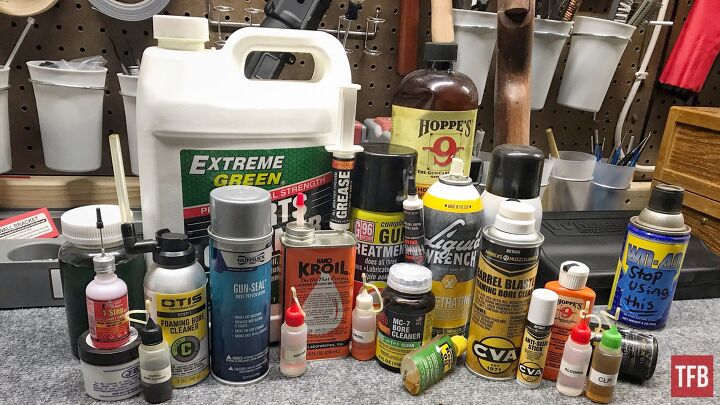Welcome everyone to the TFB Armorer’s Bench! As mentioned in the little blurb, this series will focus on a lot of home armorer and gunsmith activities. In this article sponsored by Wheeler, Tipton, Caldwell, and Frankford Arsenal, I decided to take a break from AR15 disassembly since I am on vacation and far away from my bench as I write this. Today I wanted to talk about gunsmith/armorer liquids. One of the more mundane day-to-day things that a gunsmith has to deal with is cleaning guns. This could be one gun from a single range session or even grandpa’s old 22 that was left in the barn for the last 30 years. Regardless, at its core, it is job security because cleaning a gun as a service is valid. I figured I should go over a loose list of “gunsmithing liquids” and my recommendations for said cleaning supplies. Let’s dive right into the liquids that are straight from my bench!
TFB Armorer’s Bench: Straight From My Bench – Gunsmithing Liquids
Welcome to our recurring series of Armorer’s Bench which is made possible and brought to you by Wheeler, Tipton, Caldwell, and Frankford Arsenal who are our sponsors. Here, we at TFB hope to inform, entertain, and even inspire any would-be gunsmith or armorer out there. Ideally, with the information I provide and with the help of our sponsors, you can have some useful knowledge pertaining to the conservation and improvement of firearms technology while at the same time sharing experiences and teaching each other new tips and tricks along the way in the comments. Digging deep into what it is to be an armorer or gunsmith has significance but what is important is what those people do to show they’ve earned that title. I am happy to share my experiences and knowledge and hope it is informative!
Make your personal safety a priority:
- Practice proper gun safety. Always make sure before the firearm hits your bench that it is unloaded and safe to be handled.
- Wear the proper safety equipment. The main one would be safety glasses (decent ones) since parts are often under spring tension and you may work with high RPM tools. Other honorable mentions would be latex gloves or a respirator when working with potentially harmful solvents and oils. Also hearing protection when working with loud machinery or test-firing firearms.
- Modifications, alterations, and customizations will void your firearm’s warranty 9.5 times out of 10. Please take that into consideration before attempting any at-home gunsmithing.
- If you are unsure about proper safety practices, disassembly procedures, or warranty standards, stop, put down the tools, and consult a competent gunsmith.
Gunsmithing Liquids: WD40
Just want to get this out of the way. DO NOT USE THIS ON YOUR GUN! One of the first things I learned going into school for gunsmithing was this is a frequent occurrence. People end up using WD40 because it is an available, well-known, and common household item. People use it as one of those do-all sprays around their property. They use it to lubricate door hinges, to un-stuck rusted bolts, and heck they probably also use it to kill bugs. It is too obtainable and affordable so that means some people end up throwing it inside a gun.
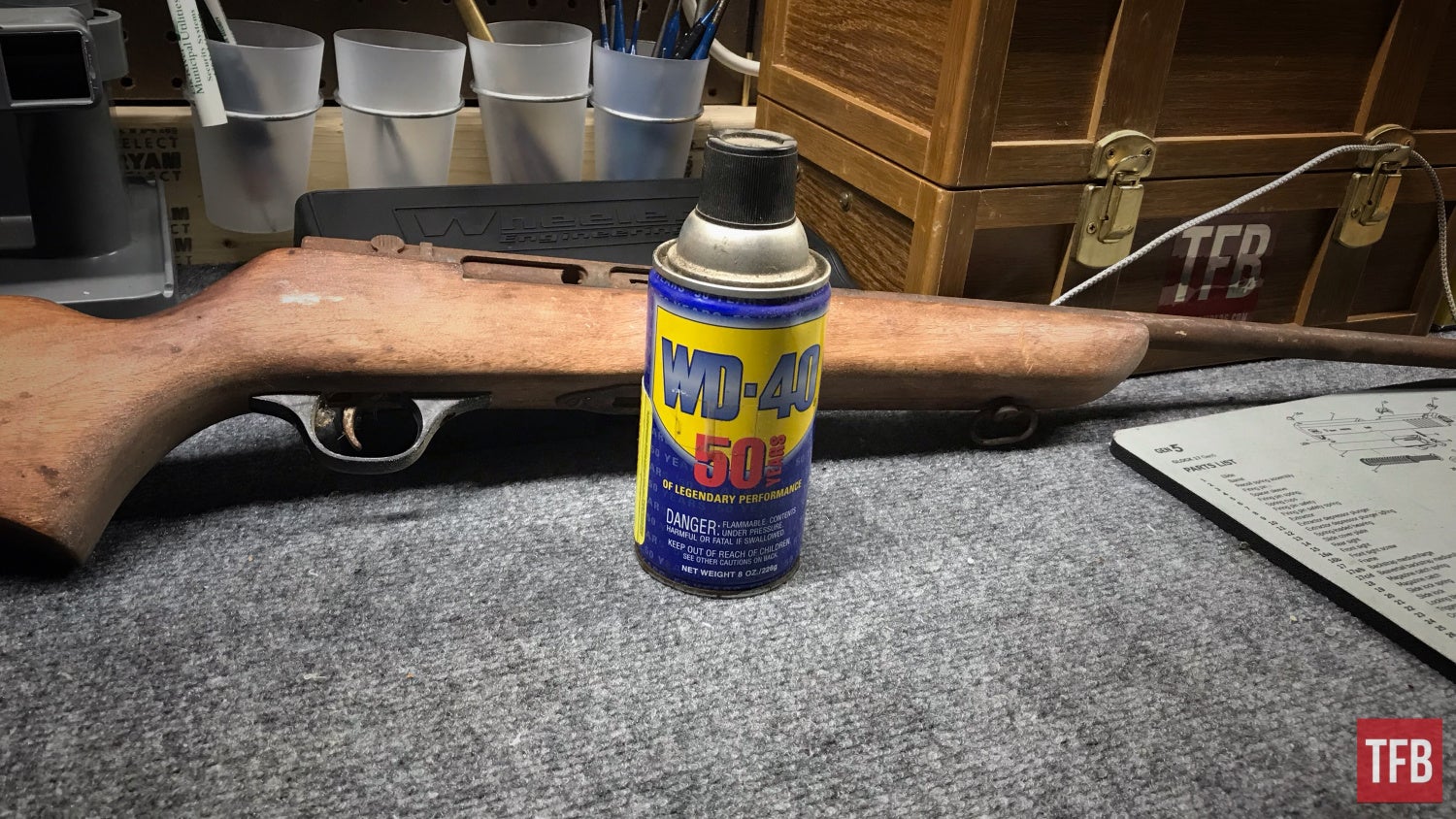
The main reason Water Displacement 40 is a poor gun cleaner or lubricant is simply that it is not made for it. If it is sprayed anywhere and let be for a prolonged amount of time, it will typically turn from a liquid to a solid gel type of material. I have seen firsthand a whole trigger assembly completely seized up by a greasy gel substance that once was WD40. If someone absolutely had to use it on their gun, the only excusable usage would be as a protectant. Something to wipe down a gun after a rough day at the range or before placing it into your safe or cabinet. Even then there are much better more suitable liquids available!
Gunsmithing Liquids: Protectant
Briefly touched on above, a protectant is used to wipe down a gun and its parts in order to leave behind a layer of protection from water and potential future rust. These are a must-have in terms of gunsmithing liquids! This is a part of proper firearm maintenance and should be done regardless of how much you clean your gun. Every time you go to the range and shoot, you are exposing your firearm to frequent pressure and temperature changes unrelated to environmental things that also affect your firearm. Your gun should always be wiped down with some form of protectant before being put in the safe or slide back under the bed.
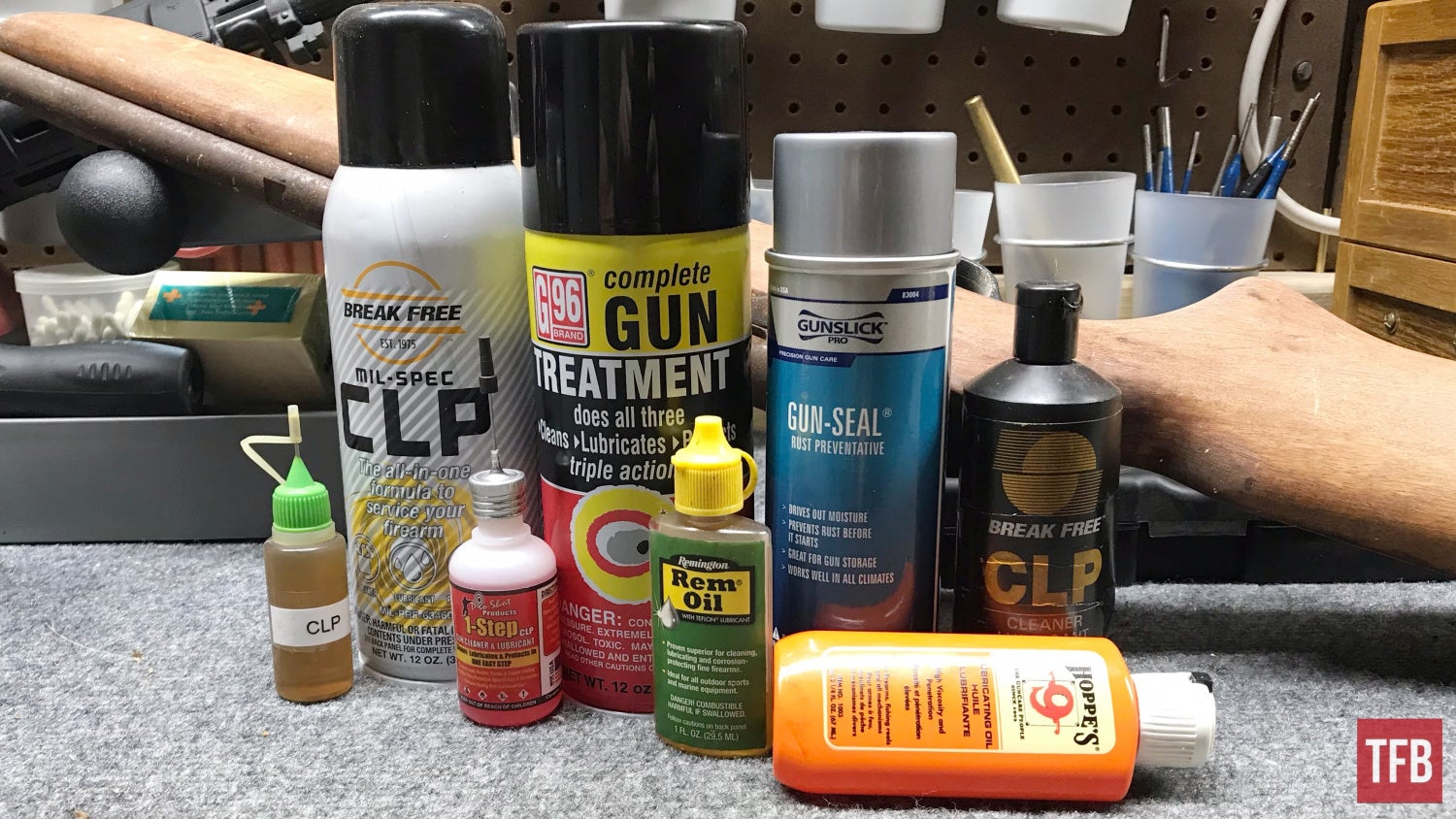
Protectants are very close cousins to lubricants since they share a similar quality in their oil content. This means that they can be used in tandem or even just get a do-all style of lubricant that also protects. I personally use either G96, CLP, or some discontinued Gunslick “Gun Seal”. G96 and CLP are super similar in that they are sort of both CLP. G96 is my favorite however since it somewhat smells like bubblegum. More pleasant than CLP fumes anyway. The Gun Seal stuff is a handy one that I keep in my safe as a reminder to wipe down my guns whenever they are returning. It comes out a little heavier in a way and stays as is on a gun. When wiped off, there is a nice thin layer of prolonged protection. I recommend wiping down an unused gun (a gun that sits in the back of the safe) with a protectant about every six months depending on how it is stored.
When you use a protectant you should avoid soaking a gun in it. All you need to spray/pour some on a rag and literally wipe it all over a gun. It is okay to get some on wood stocks or forends but I would keep an eye on it so that it is not applied so generously that it soaks into the wood and potentially compromises it. Make sure to keep it out of the bore!
Note: I do not recommend using Remoil as a protectant since it is what I would refer to as a “dry lube”. Remoil has a habit of completely drying off of a gun in a matter of days and then you are back where you started. It works fine as a lubricant especially at the moment it is applied but there are better options for a long-term protectant.
Gunsmithing Liquids: Lubricant
Lubricants are probably the head of the trinity (Solvents, Lubricants, Protectants) of gunsmithing liquids. The reason I say this is they usually are plenty capable of filling the protectant and lubricant roles fine. There are options out there that say they are also used to clean but in my opinion, I would go with a literal cleaner over a do-all option. Kind of like how shampoo and conditioner should not be in one bottle…
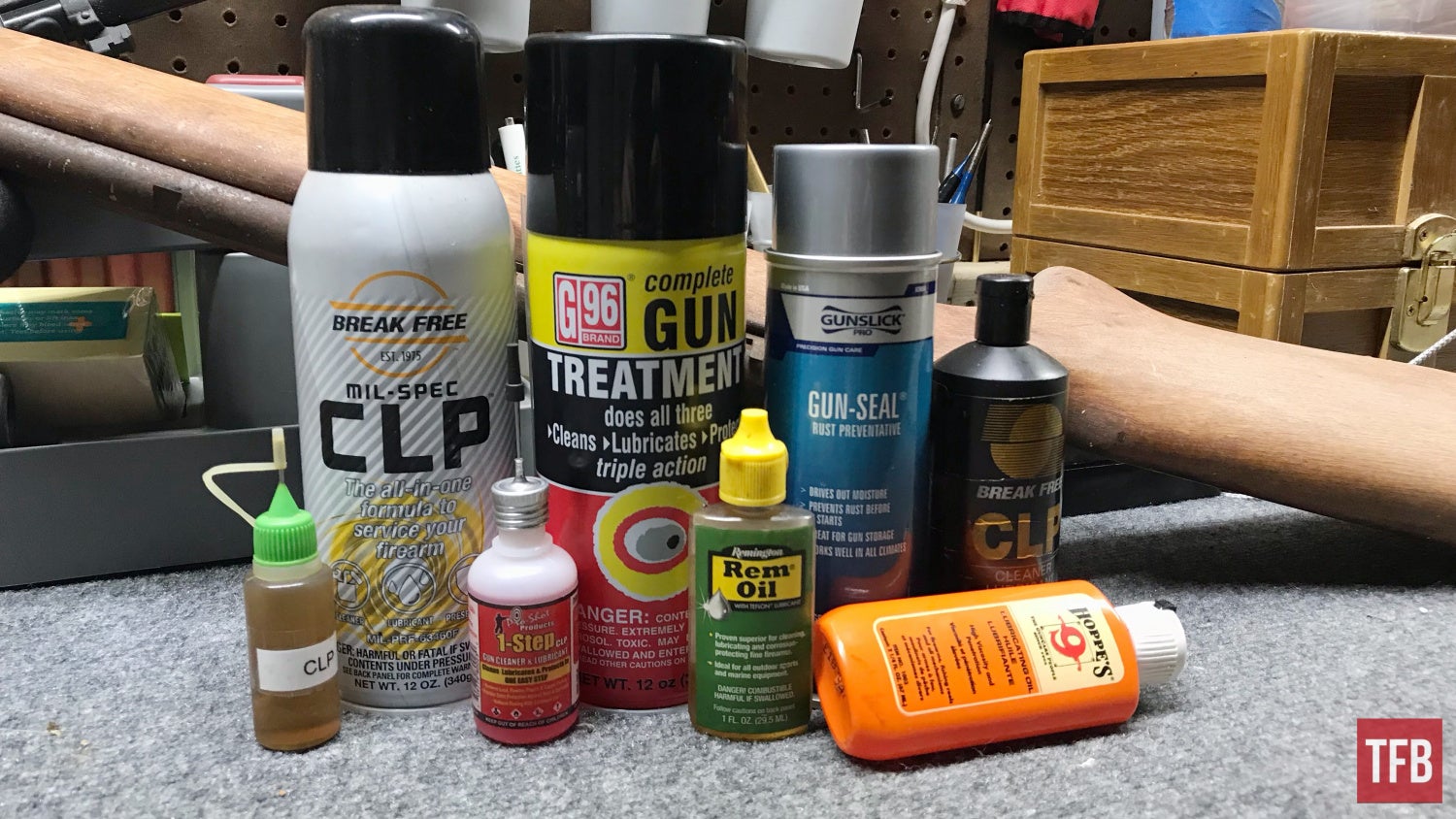
As previously mentioned, I really like G96 and CLP (Clean, Lubricate, Protect) and consider them basically the same but one is more pleasant than the other. Otherwise, Hoppe’s makes a lubricant that is a little thicker than traditional CLP. Remoil is a decent lubricant although when applied it is very thin and does not seem to last super long. This is not necessarily a bad thing since you do not want to drench any parts or have one part seem onto intentionally nonlubricated parts. Otherwise, you may see I have some Proshot CLP and that is comparable to the Remoil in that it applies very thin but it has more long-term lubrication qualities like CLP and G96.
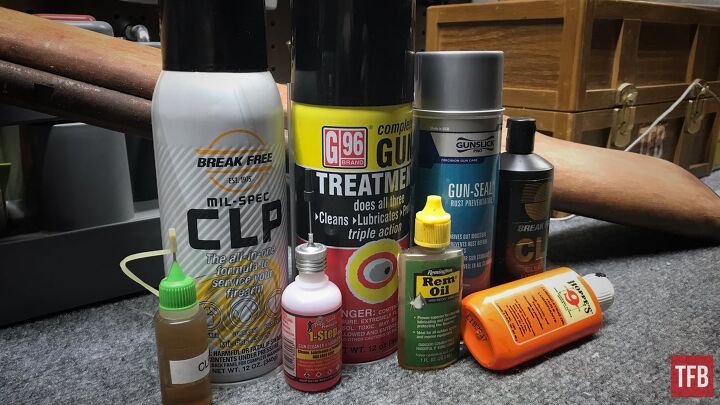
Typically lubricants should be applied to parts like the bolt of a gun and moving parts unrelated to the trigger assembly. Lubricants in a trigger assembly should be applied VERY lightly and cautiously since for the most part, they do not need it. Coiled springs usually should be lubricated with a heavier form of lubricant called grease.
Note: Make sure to keep lubricant away from parts that need friction in order to function. An example would be not to lubricate the magazine tube on a browning Auto 5 since the friction rings need friction to operate correctly.
Gunsmithing Liquids: Grease
Grease is like the heavier semisolid brother of lubricants and can be used as a lubricant but normally not as a protectant unless we are talking about storing guns for decades (like cosmoline). Grease is useful in that it can be put on a part or where two parts meet and function together and then stay there. Lubricants usually spread out and drip into other workings which is usually alright but can be a bother. Grease is great for springs unless they rely on friction to perform their intended function. Otherwise, guide rods are a good place for grease as well.
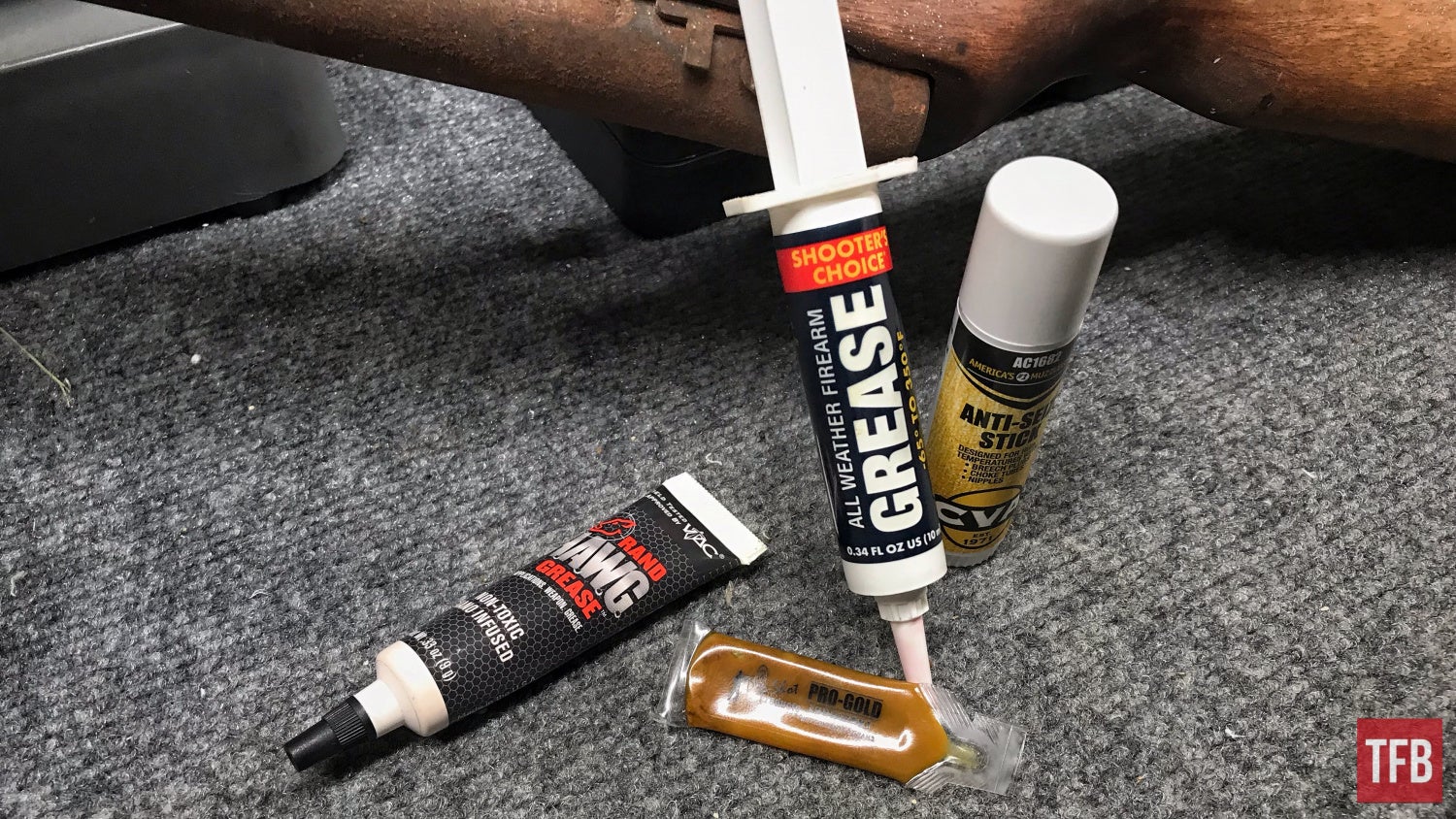
This is one that I do not particularly have a recommendation for in regards to which grease to use. I use whatever is branded as gun grease, however. It is more convenient if they come in a container like a syringe so that they can be applied with pinpoint precision. Otherwise, pick up some cheap small paintbrushes to help apply coats of grease on necessary parts.
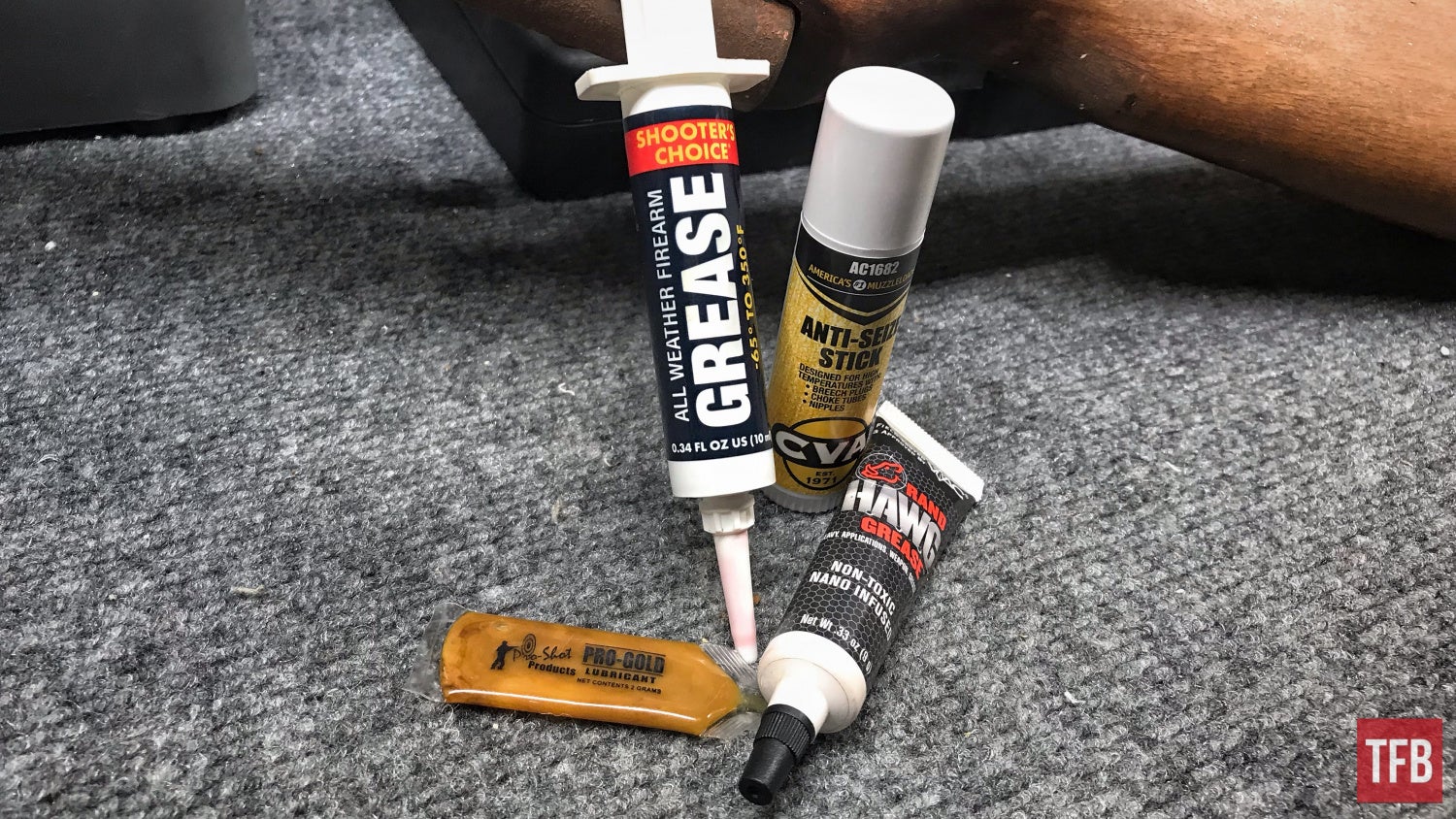
I included some anti-seize in the grease photo because they are very similar and can be used interchangeably. Anti-seize sort of products are made for choke tubes and breech plugs on muzzleloaders. Convenient ones like this CVA option come in a glue stick style which I find very useful.
Gunsmithing Liquids: Solvent (Bore/Fouling Cleaner)
Solvents are a must when cleaning a gun. If lubricants are used to clean a barrel, the layer of protection they leave behind has the potential to bulge or rupture a barrel. At the very least it can cause unsafe pressures. Solvents have qualities that break down carbon, fouling, and lead deposits. They can be used to clean internal parts but this should be done lightly and gently.
I personally prefer foaming bore cleaners. It is convenient to foam the bore, set it up so it flows out the muzzle, and then go do something else while you let it soak in. From there you can clean the bore and repeat the process if needed. Otherwise, another perk of foaming bore cleaner is that it usually is not as noxious or overpowering in its fumes like literally liquid solvents.
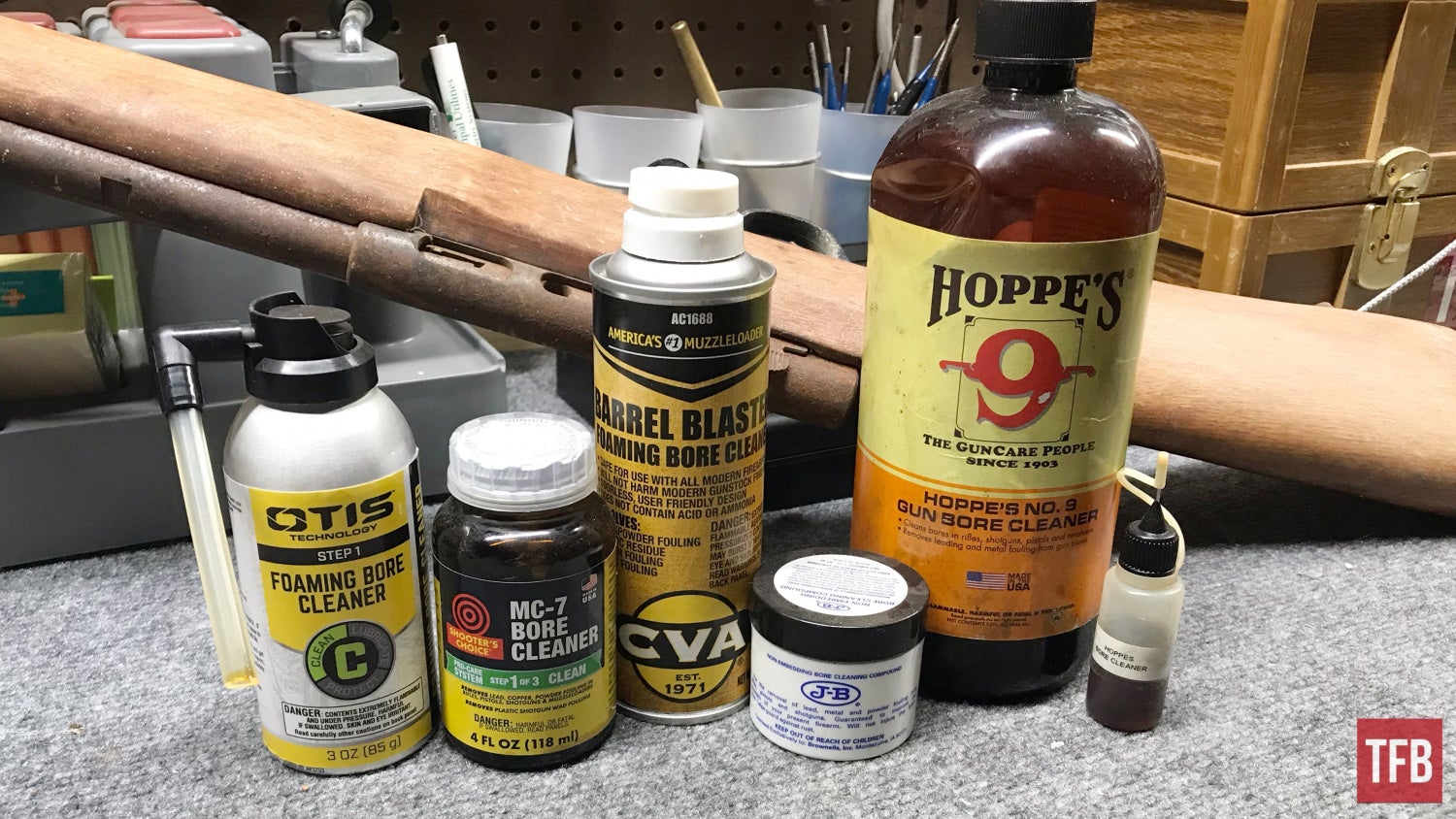
Otis makes a foaming bore cleaner that works well but I have found good results with CVA’s foaming bore cleaner that is geared more towards cleaning muzzleloaders. Something about it just delivers a better kick to that crud in your gun. Otherwise, Hoppe’s No. 9 has been around since forever and has its own cult following. The smell gets old but I would say it has nothing on MC-7 which can be pretty harsh in its nature. If you need a way to soak parts in a solvent, I would recommend using a paint tray (ideally heavy-duty plastic).
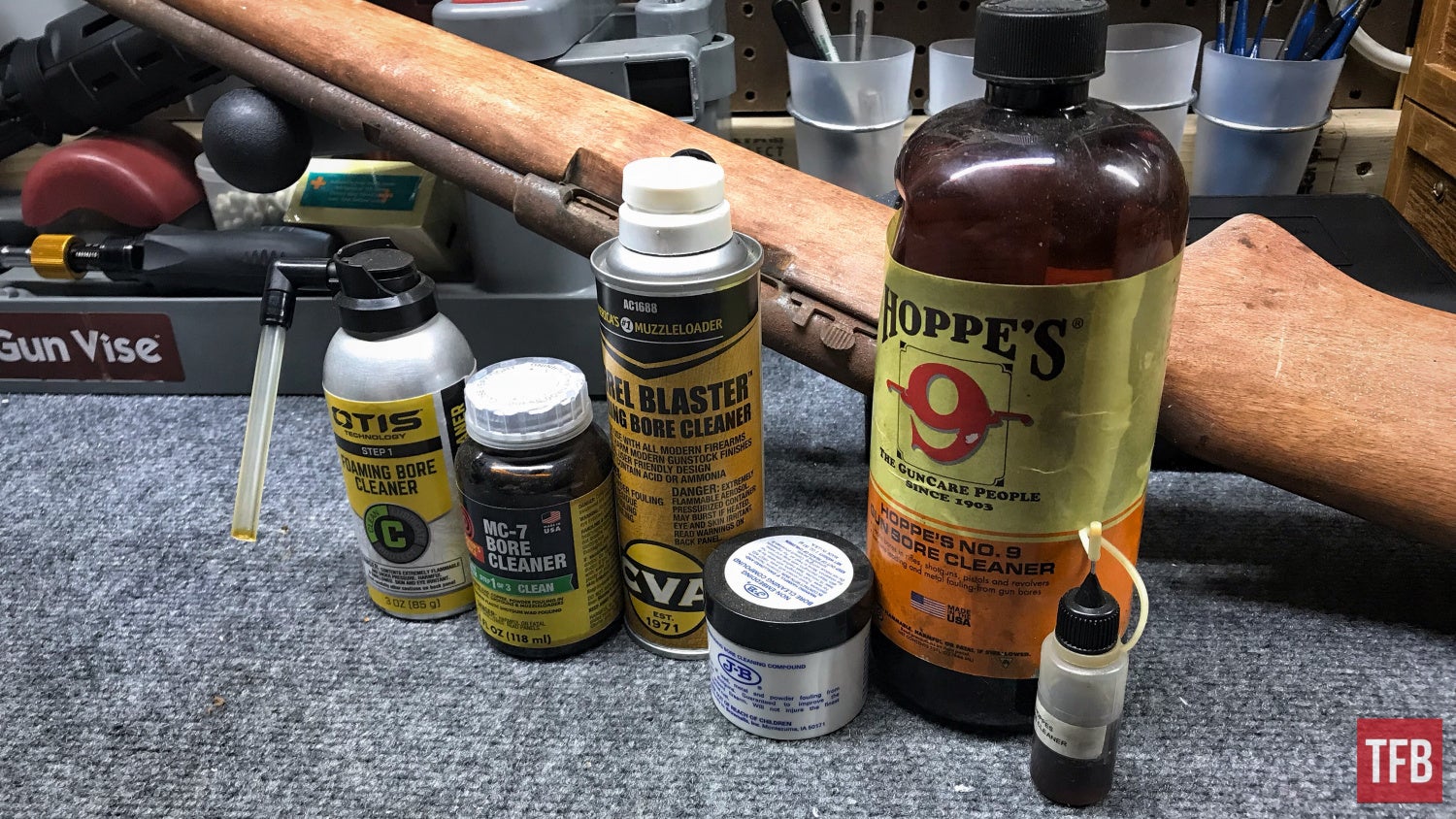
Note: All of that being said, I always recommend wearing some form of hand protection since all of this will expose you to harsh chemicals and lead exposure. Make sure to do this sort of stuff in a well-ventilated area. Make sure to get all the bore cleaner out of the bore with a patch or two and to wipe down any parts with a protectant after exposing them to a solvent.
Gunsmithing Liquids: General Cleaner
A general cleaner is similar to solvents just not as harsh in how it works. I still will tell you to work with gloves since you are working with lead fouling and a liquid that can soak into your skin. General cleaner to me is at its core soapy water. With the inclusion of water, this means you must wipe down everything with a protectant. I use the automotive cleaner pictured with a ratio that I guess would be two parts cleaner to one part of water. This is good for soaking parts that have recent or loose deposits or fouling. From the soak you scrub with a nylon brush and all should be well!
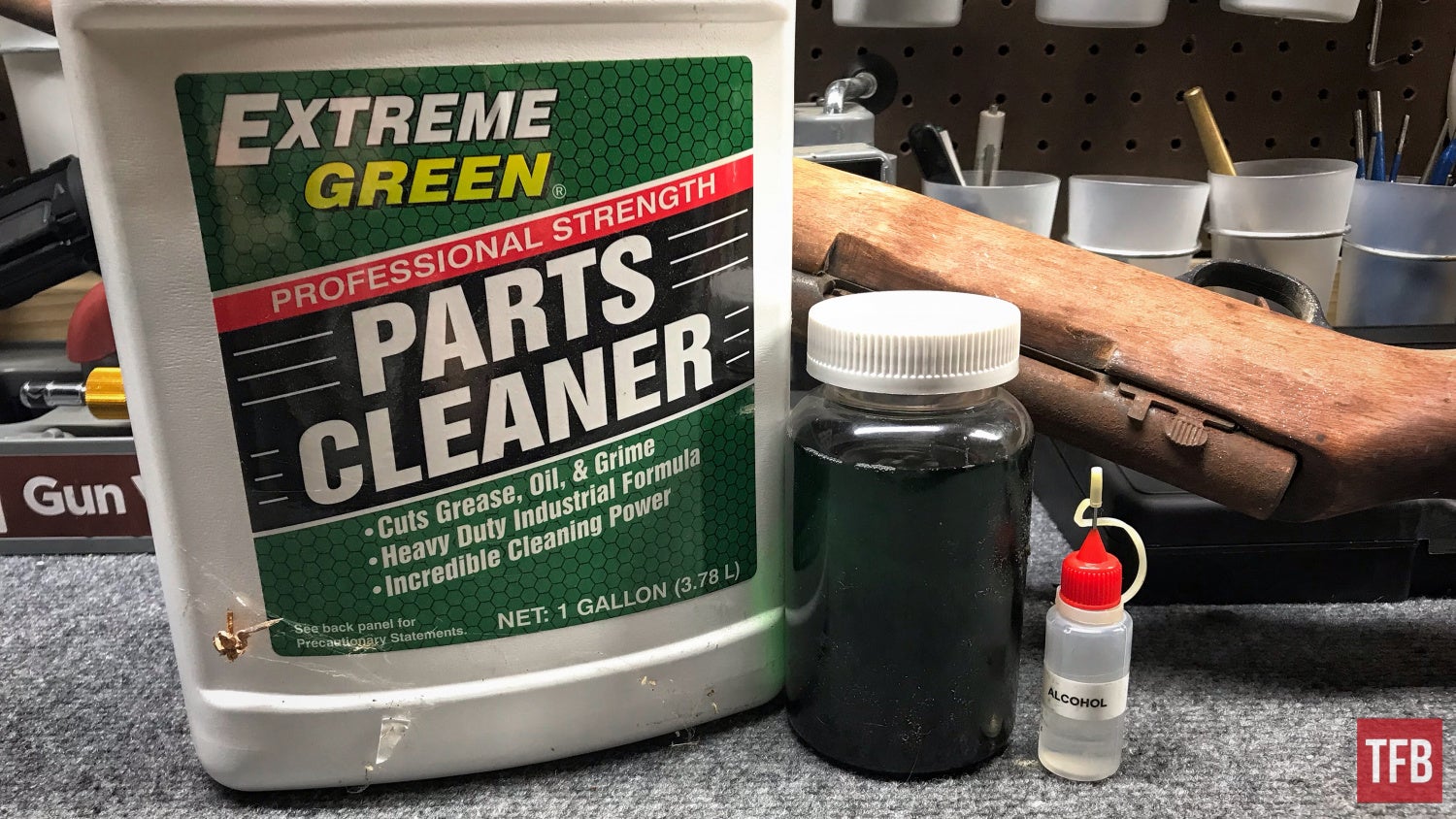
I have also included my little dropper bottle of alcohol as a cleaner since it is very good at getting rid of greasy substances. This could be cosmoline in a crevice or glue from a sticker or something similar. You never should apply loads of it to a gun. A little goes a long way. Once again make sure to apply a protectant to parts that are exposed to alcohol or water.
Gunsmithing Liquids: Penetrating Oil
Penetrating oil is one of those things that have a very necessary place on a workbench. Heat is something that works great for loosening parts but what if wood or plastic are nearby? What if you are afraid of changing a temper or heat treatment of a part by exposing it to heat? This is when penetrating oil shines! Penetrating oil is applied around screws or threaded parts almost exclusively and its job is to soak into the spiral of threads and break up the sealing characteristics of rust, glue, or Locktite. This is typically a process that takes time so be patient. Give a part anywhere from 30 minutes to a few hours if it really is being a pain.

Kroil is another one of those gunsmithing liquids with a cult following. So much so that Kroil was all we used for penetrating oil when I was in school for gunsmithing. It does in fact work but if I find myself still struggling I turn to something like Liquid Wrench which is not only cheaper than Kroil but it works better overall.

Acetone is a common enough household item (like nail polish remover) so it usually can find its way to the bench and has been proven as a decent penetrating oil so to speak. The problem with using acetone is that it is a harsher chemical in general and can eat at polymer parts and especially wood finishes! Be wary of using it.
Slick Finale: Gunsmithing Liquids
Well, there you have it, folks! I hope this article on gunsmithing liquids was an informative exercise and a good break from taking guns apart. Just remember, I am by no means the end all beat all source on gunsmithing information and advice. I highly encourage you to research what best works for your needs and to always remember to take safety into consideration when working with liquids like the ones mentioned above. Be kind and talk with each other and share experiences and recommendations and try to help each other out. Stay safe out there!
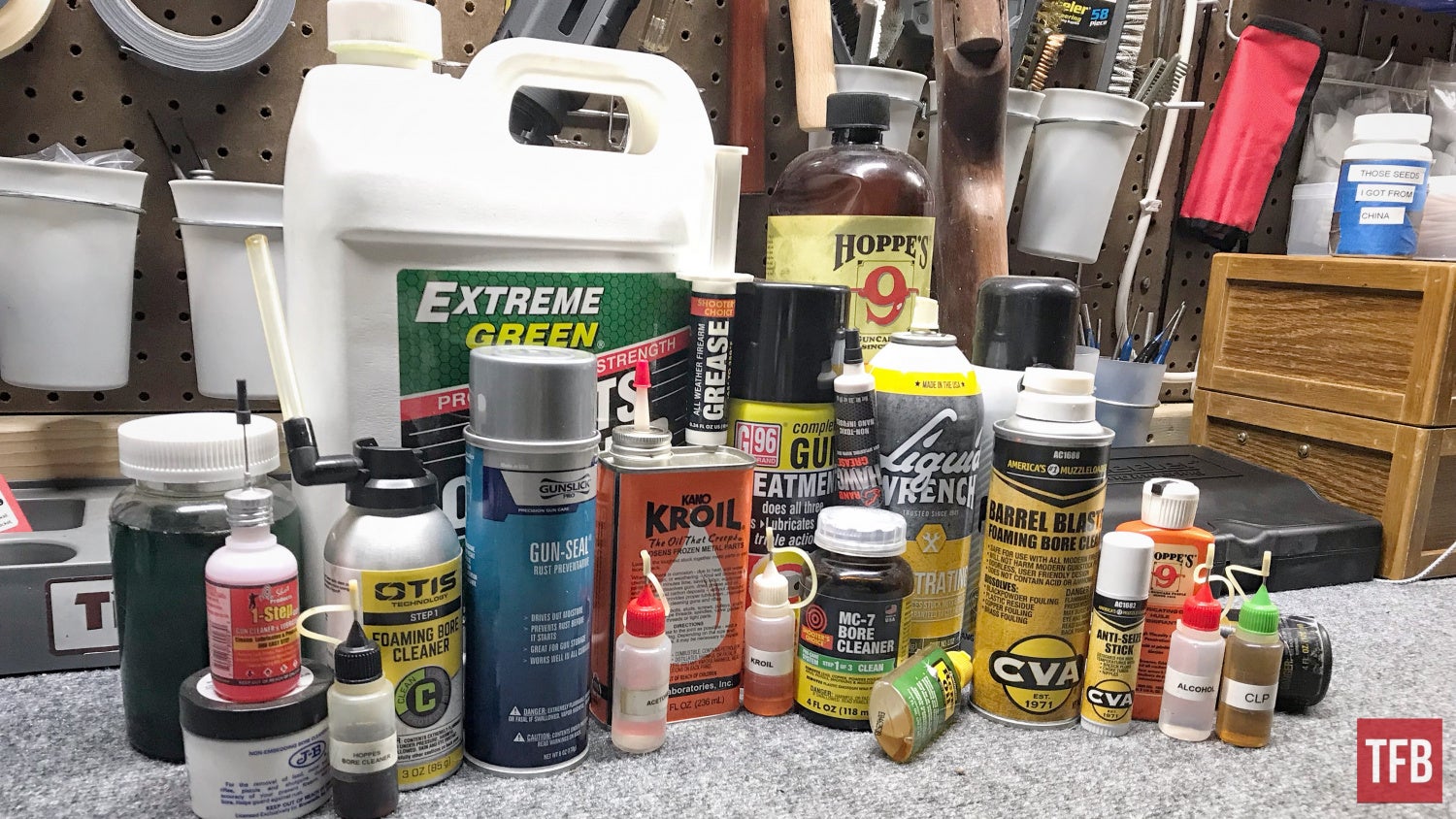
As always, thank you for reading TFB! Be safe out there, have fun while shooting, and we will see you next time for the TFB Armorer’s Bench brought to you by Wheeler, Tipton, Caldwell, and Frankford Arsenal! Also, let us know what you think in the comments below! We always appreciate your feedback.
Pro Range Glasses, Clear

The Caldwell® Pro Range Glasses feature a stylish wrap-around design and are a great choice for all shooters. They feature an adjustable nose piece and temples for all day comfort. The scratch resistant lens meets ANSI Z87.1 standards and offers 99.9% UV protection.
CLEAN AND OIL BRUSH
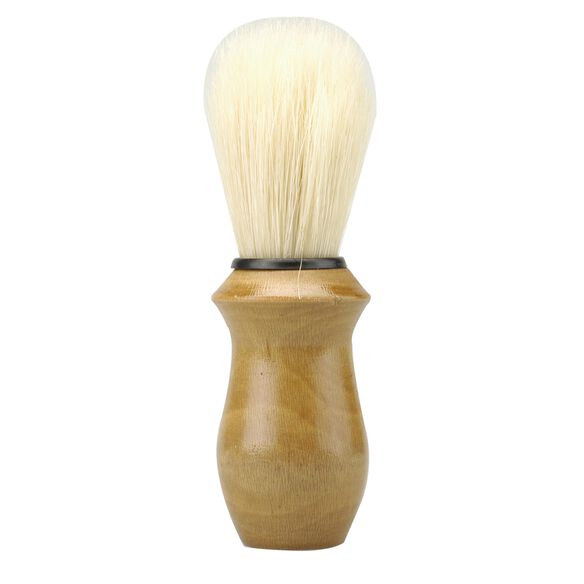 Fine natural bristle cleaning and oil application brush. Contains hundreds of soft 1-3/4″ bristles for cleaning and carrying oil and preservatives to the exterior of your guns, and the hard-to-reach areas like under vent ribs.
Fine natural bristle cleaning and oil application brush. Contains hundreds of soft 1-3/4″ bristles for cleaning and carrying oil and preservatives to the exterior of your guns, and the hard-to-reach areas like under vent ribs.
Delta Series Bore Guide
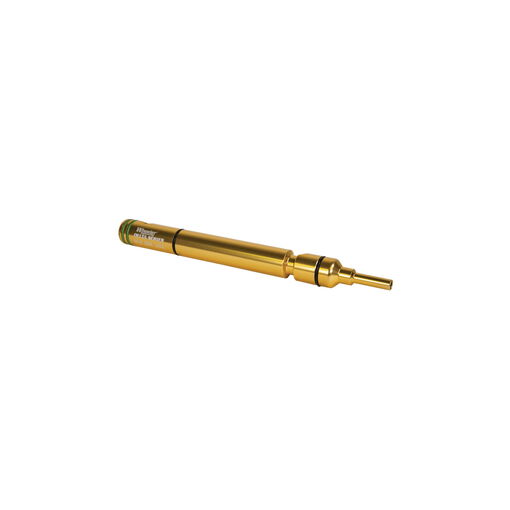
The AR-15 Bore Guide is precision CNC machined aluminum with a durable anodized finish. It fits securely in any AR-15 upper and can be retained in place by closing the dust cover on the upper which engages a groove in the guide. The bore guide also has chemical resistant O-rings for retention in uppers without dust covers. It works well with .223 and .204, extending inside the chamber to prevent solvent from leaking into the action. A solvent port is conveniently located to the rear of the guide which extends out of the upper making it easily accessible during cleaning. Inner tube diameter .250″ (not intended for 6.8mm jag). The Delta Series AR-15 Bore Guide will help protect the bore and action of your rifle by properly aligning the cleaning rod and reducing solvent overflow. Cleaning without a bore guide can allow the rod to “bow” and rub or gouge chamber and throat of the bore causing real damage and loss of accuracy. Keeping the rod properly aligned not only protects your barrel, it directs the force exerted on the cleaning rod handle allowing tight patches to be pushed more easily.
ULTRA CLEANING KIT

The Tipton® Ultra Cleaning Kit was designed for the shooter who wants the absolute highest quality cleaning accessories available in one convenient portable kit. The heart of the kit is a Premium 3 Piece Stainless Steel Cleaning Rod with a multi-bearing handle. The .205” diameter, 40” usable length rod is constructed of 17-4 PH stainless to be extremely durable and resist taking a bend (the problem that plagues most multi-section rods). All the kit components are neatly contained in the molded plastic case with custom die cut foam for organization. For use with .22 Cal and larger rifles.
Tipton Best Gun Vise
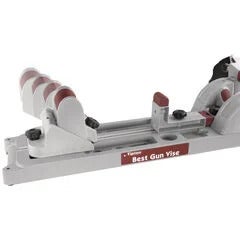
AR Maintenance Mat
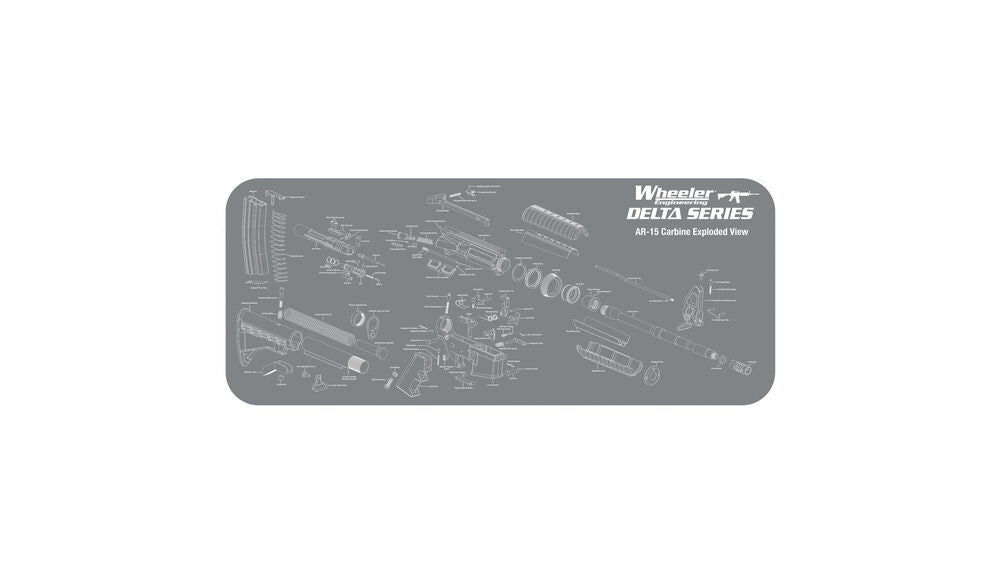 The Wheeler Delta Series AR-15 Maintenance Mat is perfect for any AR-15 owner. It features a screen printed expanded view of an AR-15 Carbine to easily identify the parts of your rifle. The Mat is made of a dark gray non-marring padded neoprene material with a durable non-skid rubber backing to protect firearm finishes while helping to keep track of small parts. Excess oils and solvents are absorbed into the mat, keeping the surface clean and dry. Each mat is machine or hand washable with mild detergent and water, and can be rolled up to easily fit in your range bag.
The Wheeler Delta Series AR-15 Maintenance Mat is perfect for any AR-15 owner. It features a screen printed expanded view of an AR-15 Carbine to easily identify the parts of your rifle. The Mat is made of a dark gray non-marring padded neoprene material with a durable non-skid rubber backing to protect firearm finishes while helping to keep track of small parts. Excess oils and solvents are absorbed into the mat, keeping the surface clean and dry. Each mat is machine or hand washable with mild detergent and water, and can be rolled up to easily fit in your range bag.
 Your Privacy Choices
Your Privacy Choices
